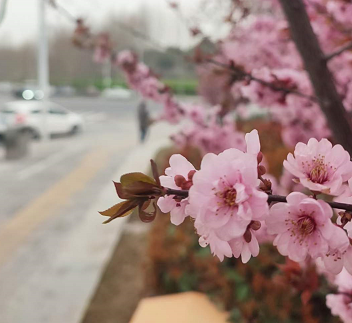Suburb tourism drives the "flower appreciation economy" to develop "secondary consumption", which needs to do something about "flowers"

You may also be interested in:
-
Suburb tourism drives the development of "flower appreciation economy" and "secondary consumption" -
There are still some shortcomings in the improvement of China's consumption environment -
A number of luxury brands have reported price increases -
Pharmaceutical giant Roche's sales increased by 10% in the first quarter -
Twitter is reported to be ready to accept Musk's offer as soon as -
Jinhui Liquor: in the first quarter of 2022, the revenue of high-end liquor will increase by 44.51% -
Little mouse becomes a money spinner! Gross profit rate directly catches up with Moutai, Yaokang -
Langjiu's seven year crackdown on counterfeits: Linlang's trademark infringement has been enforced
Today's Hot Spots
Recommended for you
more
-
Annual output of 2.4 million 12 inch epitaxial chips! Zhongxin wafer project will be trial produced -
Samsung joined the $25 million financing plan of Korean veteran startup DoubleMe -
Graphene's Quantum Magic Brings New Superconducting Materials -
Mendix and ValueMomentum upgraded their partnership to create greater value for customers -
Softcom Power's first SwanLinkOS commercial display release has passed the certification -
CommScope's view: intelligent network is the way to success -
Codasip expands the automotive processor team and appoints Jamie Broome as the vice president in charge of the business -
China's global innovation index rose to 12th place, with 2.531 million invention patents in the past five years
more
-
Huadian Economic Development Zone has launched a "combination of investment promotion" to sign 7 projects in food processing and other fields -
Overseas Chinese Town Group will pay interest at 3.5% of the 1.4 billion yuan medium-term note -
Bank of China successfully issued 2.05 billion US dollar equivalent overseas green bonds -
Xining Chengtou 800 million yuan medium-term note will pay interest on April 30, bond interest rate 6.5% -
The manufacturer of the laptop industry has cut down the shipment target for June or again -
Zhongnan Construction (000961. SZ) plans to issue debt financing instruments of no more than 10 billion yuan -
The RRR reduction has come as scheduled, and the trend channel of further "double decline" still exists in the future -
Wenzhou Urban Construction plans to issue ultra short-term financing bonds of no more than 480 million yuan, with a subscription range of 2% - 3%
Ranking
-
How can the "Cantonese style prefabricated dishes" break through the barrier of the rise of prefabricated dishes across the country? -
China has steadily ranked as the world's largest manufacturing country, and its high-quality development has reached a new level -
Which of the 13 new first tier cities with GDP exceeding one trillion yuan is more dynamic? -
Real estate enterprises have good business performance. Why does the real estate share price keep falling? -
The new elderly: the perception and rationality of consumption coexist, and shopping has shifted from the "old three" to the "new -
China Olympic Park ranked 849 in Forbes Global 2000, and jumped 303 places -
In the context of digital reform, Hangzhou uses "industrial brain" to empower urban industrial governance -
Jiangxi will realize the transformation from "tax management by bills" to "tax management by numbers" classified and precise supervision -
The added value of industries above designated size increased by 6.4% in July, and 14.4% in the previous July -
Under the background of normalization of epidemic situation, how should local governments develop tourism?
Recent updates
-
Suburb tourism drives the "flower appreciation economy" to develop "secondary consumption", which needs to do something about "flowers" -
There are still shortcomings in the improvement of China's consumption environment. Online transaction consumer protection faces new challenges -
Last year, the national customs took 84000 measures to protect intellectual property rights, and cross-border e-commerce became the focus of law enforcement -
ST Lawton (600209) executives are suspected of deliberately delisting, and Tianjian Certified Public Accountants has revealed 71 million black holes -
Announcement Gold Rushing 2022.04.26 -
How to prolong the shelf life of mulberry -
How long is the shelf life of fresh mulberry -
Reorganization of outlets resources of big banks -
What's the hot thing about mud moxibustion -
Promote financial support for high-quality development of highway transportation -
The supply quality of life insurance products has steadily improved -
Special party expenses of municipal organ working committee to help fight epidemic -
The application of Zhende Medical Products Co., Ltd. for non-public offering of shares was approved by China -
Notice on Suspension of Fever Clinic of Harbin First Hospital -
A person with abnormal nucleic acid detection was found in Donggang City -
The Municipal Center for Disease Control and Prevention reminds us to pay attention to these problems -
25 new confirmed cases of indigenous COVID-19 and 39 new asymptomatic infections in Liaoning Province -
Financial institutions break through the highway traffic financing blockages to promote high-quality development of highway transportation industry -
Four Measures of Qingyang County to Promote Outpatient Medical Services for the Elderly to Facilitate People's Livelihood -
On April 25, 25 newly confirmed cases of local COVID-19 were added in Liaoning Province, and 39 newly confirmed cases of local COVID-19 were not found -
The head is swollen and painful. It's tuberculous meningitis -
On April 25, 2 new local confirmed cases were found in Hebei, 49 new local asymptomatic infections were found -
China Consumer Association advocates operators to provide green environmental protection products and consumers to practice the concept of simplicity and moderation -
Huadian Economic Development Zone has launched a "combination of investment promotion" to sign 7 projects in food processing and other fields -
Several luxury brands report price increases. Consumers should live within their means and consume rationally -
Fengtai District of Beijing launched the "point-to-point" replenishment mechanism to effectively guarantee the "food basket" of the capital -
Overseas Chinese Town Group will pay interest at 3.5% of the 1.4 billion yuan medium-term note -
In order to alleviate the negative impact of soaring prices, the Japanese government is said to increase aid by 6 trillion yen -
Meta's first offline store opens in two weeks: a variety of VR devices for consumers to experience on the spot -
Twitter has learned that it is ready to accept Musk's offer and will reach an acquisition agreement as soon as Monday
this Daily news
-
Suburb tourism drives the "flower appreciation economy" to develop "secondary consumption", which needs to do something about "flowers" -
There are still shortcomings in the improvement of China's consumption environment. Online transaction consumer protection faces new challenges -
Last year, the national customs took 84000 measures to protect intellectual property rights, and cross-border e-commerce became the focus of law enforcement -
Financial institutions break through the highway traffic financing blockages to promote high-quality development of highway transportation industry -
China Consumer Association advocates operators to provide green environmental protection products and consumers to practice the concept of simplicity and moderation -
Huadian Economic Development Zone has launched a "combination of investment promotion" to sign 7 projects in food processing and other fields -
Several luxury brands report price increases. Consumers should live within their means and consume rationally -
Fengtai District of Beijing launched the "point-to-point" replenishment mechanism to effectively guarantee the "food basket" of the capital -
In order to alleviate the negative impact of soaring prices, the Japanese government is said to increase aid by 6 trillion yen -
Tesla Q1's US market revenue nearly doubled, and a large number of orders were overstocked until next year







